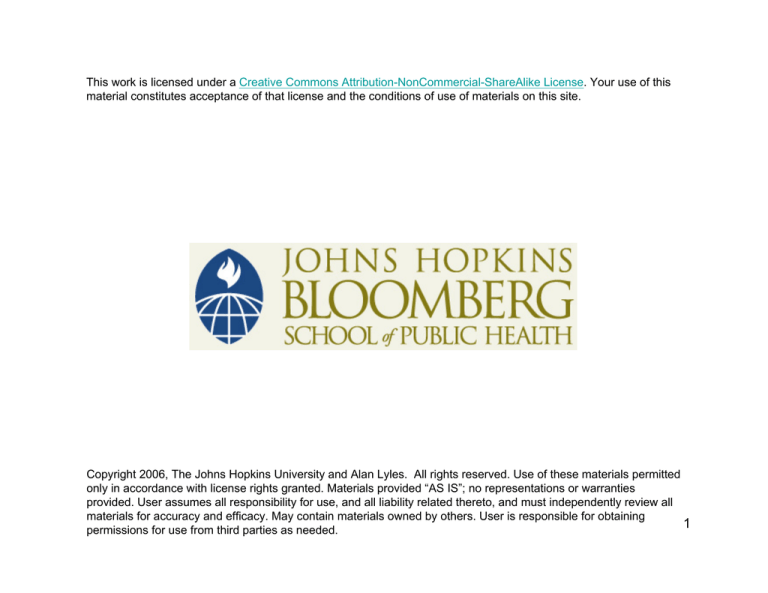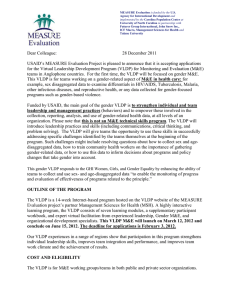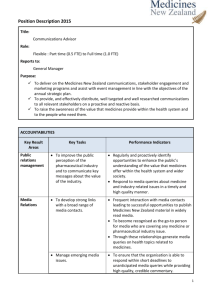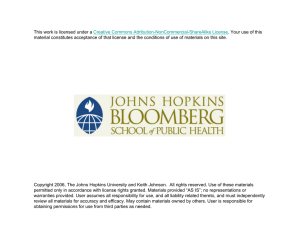
This work is licensed under a Creative Commons Attribution-NonCommercial-ShareAlike License. Your use of this
material constitutes acceptance of that license and the conditions of use of materials on this site.
Copyright 2006, The Johns Hopkins University and Alan Lyles. All rights reserved. Use of these materials permitted
only in accordance with license rights granted. Materials provided “AS IS”; no representations or warranties
provided. User assumes all responsibility for use, and all liability related thereto, and must independently review all
materials for accuracy and efficacy. May contain materials owned by others. User is responsible for obtaining
1
permissions for use from third parties as needed.
Session 1:
Pharmaceutical Products and
Under-served Populations
Alan Lyles, Johns Hopkins School of
Public Health
2
Overview of Course Sessions (1)
1. The global context of pharmaceutical products and
underserved populations
2. International Policy and Legal framework
3. Drug manufacture, industrial pharmacy considerations,
quality assurance and regulation
4. The Drug Management Cycle: Selection
5. Forecasting and Quantification
6. The Drug Management Cycle: Procurement
7. Drug Donations
8. The Drug Management Cycle: Distribution
3
Overview of Course Sessions (2)
9. The Drug Management Cycle: Use
10. Budgeting and Cost Control
11. Management Support Systems: Planning Cycle
12. Access to Essential Drugs
13. Pharmaceutical Care and Drug Utilization in an
HIV/AIDS Clinic
14. Financing and Sustainability
15. Laboratory Exercise on Planning with an Emphasis on
Budgets and Sensitivity Analysis
16. Student Presentations
4
“The right context is worth 50 IQ points.”
-Alan Kay, Inventor of Object Oriented Programming &
Laptop Computer Visionary
5
World Drug Purchases: Retail Pharmacies
IMS Health –Retail Drug Monitor: 12 Months to Sept 2005*
Sept 2005
Sept 2004
% Growth US$
% Growth Constant
Exchange
Selected World
365,348
341,483
7%
5%
North America
192,649
182,200
6%
5%
•
USA
180,994
172,182
5%
5%
•
Canada
11,656
10,017
16%
7%
Europe
90,685
84,132
8%
3%
•
Germany
27,055
24,281
11%
7%
•
France
22,639
20,641
10%
5%
•
Italy
14,619
14,249
3%
(2%)
•
UK
15,408
15,083
2%
(1%)
•
Spain
10,965
9,879
11%
6%
Source: IMS Health, Retail Drug Monitor Sept 2005 in US$ millions.
www.imshealth.com/vgn/images/portal/cit_40000873/53/63/76322469IMS%20Retail%20Drug%20Monitor%20September2005.pdf
6
World Drug Purchases: Retail Pharmacies
IMS Health –Retail Drug Monitor: 12 Months to Sept 2005*
Selected World
Japan*
Latin America†
•
Mexico
•
Brazil
•
Argentina
Australia/NZ
Sept 2005
Sept 2004
% Growth US$
% Growth Constant
Exchange
365,348
341,483
7%
5%
60,820
57,122
6%
5%
15,524
13,935
20%
19%
7,184
6,338
13%
11%
6,369
4,844
31%
31%
1,971
1,752
13%
13%
5,670
5,094
11%
5%
*Including hospitals; †Leading three.
Source: IMS Health, Retail Drug Monitor Sept 2005 in US$ millions.
www.imshealth.com/vgn/images/portal/cit_40000873/53/63/76322469IMS%20Retail%20Drug%20Monitor%20September2005.pdf
7
Percent of All US Firms Offering Health
Benefits:1996-2005
Adapted from Employer Health Benefits Survey 2005. Kaiser Family Foundation.
http://www.kff.org/insurance/7315/sections/upload/7375.pdf.
8
OP Prescription Drugs as Percentage of US
National Health Expenditures: 1993 v 2003
Adapted from: Smith C, et al. Health Spending Growth Slows in 2003. Health Affairs 2005;24(1):185-194. Exhibit 5.
9
Relative Contributions to Rising US Rx
Expenditures: 1993-1997 vs 1997-2002
1993-1997
1997-2002
Price
19%
25%
Rx Type
34%
34%
Utilization
47%
42%
Adapted from: Kaiser Family Foundation. Trends and Indicators, 2004 Update, Exhibit 1.17.
10
Access Barriers: Drugs Are Costly
• Major out-of-pocket expense
• Can represent as much as 20 percent of total national
health expenditures, 60 percent of total recurrent health
expenditures
• Drug expenditures are often second only to personnel
salaries and benefits
11
Many Health Interventions Depend on
Pharmaceuticals: Prevention & ACSCs
•
•
•
•
•
•
Expanded Program on Immunization
Integrated Management of Childhood Illness
Directly Observed Treatment, Short-course
Roll Back Malaria
HIV prevention (social marketing of condoms)
AIDS treatment and care
12
Coverage Distribution
13
US Non-compliance from Out-of-Pocket Costs*
Out-Of-Pocket
Health Status
Base:
All
Adults
Have
Condition
for Rx
$0$100
$101$250
$251500
>$50
0
Excellent
to Very
Good
Fair to
Poor
Did not ask MD
for an Rx
18%
23%
14%
37%
42%
42%
12%
33%
Did not fill an
Rx
22%
30%
19%
50%
48%
44%
13%
41%
Used a lower
dose to extend
Rx
15%
21%
10%
35%
36%
41%
8%
29%
Used less than
Rx’d
18%
25%
13%
45%
42%
46%
11%
37%
Due to cost:
*Adapted from: Harris Interactive. Higher Out-of-Pocket Costs Cause Massive Non-Compliance in the Use of
Prescription Drugs, and This Is Likely to Grow. Health Care News. 2002;2(22):2. http://www.harrisinteractive.com/
14
US Rx Compliance: Disease Specific
Behaviors in the Past 12 Months
Multiple Sclerosis
Hypertension Depression
Not filled
15%
17%
30%
Delayed filling
24%
26%
41%
Taken in lower doses
than prescribed
23%
14%
25%
Taken less often than
prescribed
30%
29%
43%
Discontinued sooner than
prescribed
15%
15%
30%
Adapted from: http://www.bcg.com/publications/files/TheHiddenEpidemic_Rpt_HCDec03.pdf
15
US Rx Compliance Behaviors & Gender:
How does female compliance affect household behaviors?
Women
Men
Not filled
21%
15%
Delayed filling
30%
20%
Taken in lower doses than prescribed
15%
12%
Taken less often than prescribed
33%
26%
Discontinued sooner than prescribed
23%
18%
Adapted from: http://www.bcg.com/publications/files/TheHiddenEpidemic_Rpt_HCDec03.pdf
16
Drug coverage among Medicare
beneficiaries with CHD/MI increases use
of lifesaving drugs*
• Medicare beneficiaries with coronary heart disease
– Statins recommended to lower cholesterol
– Statins are costly
• 27.4 % with coverage used statins
• 4.1% without coverage used statins
17
What Is Known about Drug Management?
• Effective ambulatory Rx use can reduce morbidity and
mortality
• Wise drug selection underlies all other improvements
• Effective management saves money and improves
performance
• Rational drug use requires more than drug information
• Systematic assessment and monitoring are essential
18
Increased Efficiencies: Pooled
Procurement
Source: MSH: Management Sciences for Health. Used with permission.
19
Pharmaceutical Expenditures
Per Capita
($US/yr)
As % of GDP
Private
Expenditures
as % of Total
Africa
$8
0.86%
68%
Asia
$12
0.59%
76%
LA/C
$31
0.87%
75%
Developed
Economies
$137
0.65%
33%
Region
20
Understanding Medication Use
Source: MSH: Management Sciences for Health. Used with permission.
21
Geographic Accessibility: Tanzania
Distance to Health Facility
Public
Private Clinics
14% >10 km to public facility
Private Pharmacy
6% >10 km to private drug retailer
Duka La Dawa
NGO
Source: MSH: Management Sciences for Health. Used with permission.
22
Affordability:
Cambodia, El Salvador, Ghana, India
*Child 1-5 years old, co-trimoxazole; **Adult, amoxicillin
Source: MSH: Management Sciences for Health. Used with permission.
23
Pharmaceutical Management, Access, and
Use of Medicines
Source: MSH: Management Sciences for Health. Used with permission.
24
Pharmaceutical Management Cycle
Policy and Legal Framework
Source: MSH: Management Sciences for Health. Used with permission.
25
Dimensions of Access & Potential Barriers
26
Essential Medicines Definition
Essential medicines are:
– those that satisfy the priority health care needs of the
population
– selected with due regard to public health relevance,
evidence on efficacy and safety, and comparative
cost-effectiveness
– intended to be available within the context of
functioning health systems at all times in adequate
amounts, in the appropriate dosage forms, with
assured quality and adequate information, and at a
cost that individuals and the community can afford
27
Substandard Essential Medicines
in Developing Countries
Source: MSH: Management Sciences for Health. Used with permission.
28
Percentage of Medicines Prescribed from
Essential Medicines List, by Sector
Source: MSH: Management Sciences for Health. Used with permission.
29
Understanding and Improving
Access to Essential Medicines
30
Increased Efficiencies: STGs
Total Annual drug costs in a Latin American country for treatments during a cholera epidemic, costs in
millions of US$ (1991)
Source: MSH: Management Sciences for Health. Used with permission.
31
Challenges for Improved Public Drug Supply
•
•
•
•
Health reform, equity, and financial sustainability
Efficiency
Rational use
Changing roles of public and private sectors
32
Essential Medicines
Availability & Dispensing in Dispensaries
Source: MSH: Management Sciences for Health. Used with permission.
33
Number of Medicines on
National Essential Medicines Lists
Source: MSH: Management Sciences for Health. Used with permission.
34
Goals of a National Drug Policy
Health-Related
• Available essential drugs
• Improve attendance at health facilities
• Safe, affordable, and effective drugs
• Rational useProper selection of drugs
• Efficient supply
Economic
• Lower cost of drugs
• Reduce foreign exchange
• Provide jobs
• Improve efficiency and cost-effectiveness
Development
• Human resource development
• Improve infrastructure
• National production of drugs
35
Components of a National Drug Policy
•
•
•
•
•
•
•
•
•
Legislative Framework
Choice of Drugs
Supply
Rational Use of Drugs
Economic Strategies for Drugs
Human Resources Development
Monitoring and Evaluation
Research
Technical Cooperation Among Countries
36







